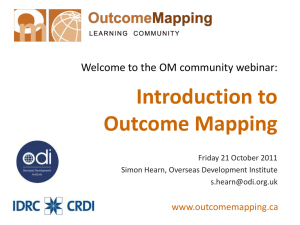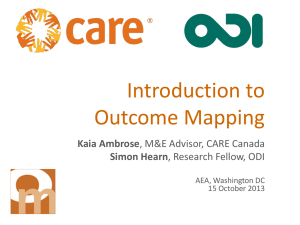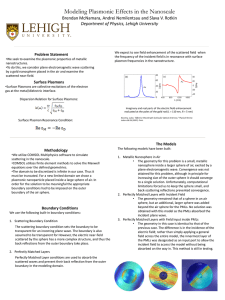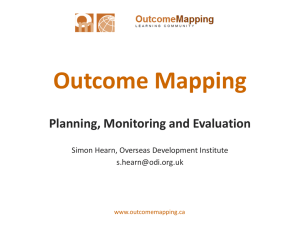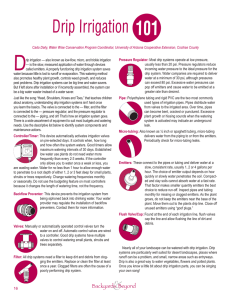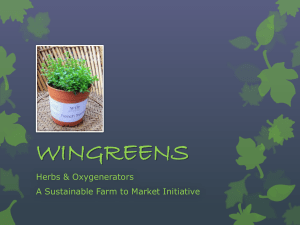Smutylo_Speaker
advertisement
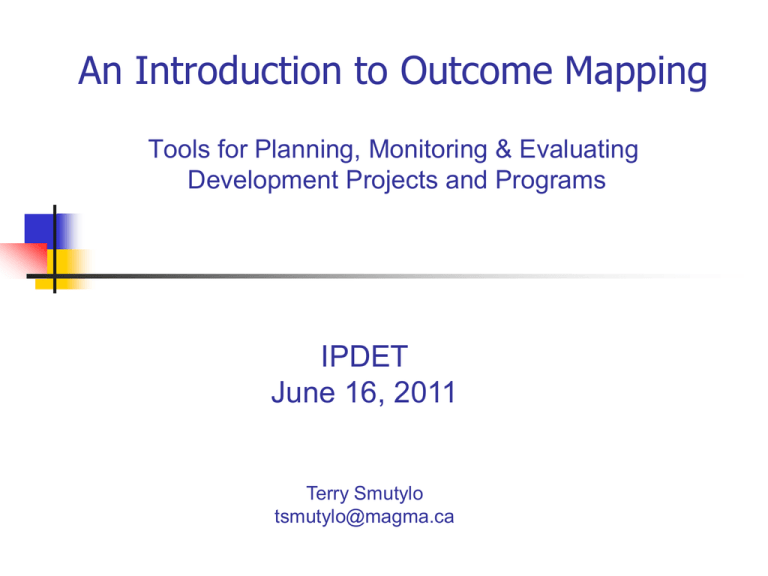
An Introduction to Outcome Mapping Tools for Planning, Monitoring & Evaluating Development Projects and Programs IPDET June 16, 2011 Terry Smutylo tsmutylo@magma.ca Objectives for this Session 1. Inspire you to search for and adapt evaluation tools to fit your context & needs 2. Introduce key concepts & tools in Outcome Mapping 2 Development interventions can be: Complex (involve a confluence of actors and factors) Unstable (independent of project duration) Non-linear (unexpected, emergent, discontinuous) Two-way (intervention may change) Beyond control (but subject to influence) Incremental, cumulative (watersheds & tipping points) 3 4 Challenges in evaluating development interventions: establishing cause & effect in open systems measuring what did not happen reporting on emerging objectives timing: success today, failure tomorrow? encouraging ongoing learning reconciling differing values, perspectives measuring ‘sustainable’ results 5 The focus of Outcome Mapping changed behavior 6 What is Outcome Mapping? A project/program management tool for: Clarifying intentions Developing strategies to achieve results Identifying information for monitoring and evaluating Fostering organizational learning Enhancing other frameworks & methods 7 7 OM: brief history 1990s: IDRC’s post-Rio search for ‘sustainable’ results 1998: Barry Kibel and Outcome Engineering 1999: Collaboration & testing within projects 2000: Publication of manual in English & French 2002: Training, facilitation & usage globally 2006: OM Learning Community: www.outcomemapping.ca 2008: CLAMA 8 Three key concepts in OM: Sphere of influence Recognizing changes in behaviour as outcomes Boundary Partners 9 There are limits to our influence Project or Program Partners sphere of influence Beneficiaries sphere of concern 10 Changes in behaviour as ‘outcomes’ outcomes inputs activities outputs sphere of influence changes in conditions, well-being changes in behaviour sphere of concern 11 12 Step 1: improved human, social, & environmental wellbeing 13 I have a dream! Martin Luther King, Jr. August 28, 1963 14 Step 2: Mission The mission is that “bite” of the vision statement on which the program is going to focus. 15 A mission statement describes: What do you do? Who are your principle collaborators? How do you work with them? 16 Vision Mission ✓ about the future ✓ feasible ✓ concrete, observable ✓ idealistic ✓ identifies activities and relationships ✓ not about the program ✓ about the program 17 Step 3: Who are our Boundary Partners? Project or Program Boundary Partners Beneficiaries other stakeholders 18 Farmers participate in field trials using drip irrigation Extension workers Participatory visit demonstration research on farms demonstration farms Training of to develop extension approaches workers to drip irrigation Publication of performance of different setups Adapted from K. Kelpin, 2009 Farmers add to own knowledge of techniques Farmers adopt drip irrigation methods Reduced numbers of new wells Greater quantities of groundwater available Extension workers explain & promote drip irrigation 19 Step 5: Progress Markers Love to see (Deep transformation) Like to see (Active engagement) Expect to see (Early positive responses) 20 Why use Progress Markers? Articulate the complexity of the change process Encourage the program to seek the most profound transformation possible Facilitate negotiation of expectations with partners Enable early assessment of progress Help identify mid-course improvements 21 21 Progress Markers – IMF examples Expect to see local communities: • Participating in regular model forest (MF) meetings • Establishing an organizational structure for cooperation • Acquiring new skills for managing model forests • Articulating a locally relevant vision for the MF Like to see local communities: 5. Contributing resources to set up their MF 6. Calling upon external experts for advice 7. Seeking out new partners for the MF Love to see local communities: 8. 9. 10. 11. 12. Obtaining funding from different national sources Publishing examples of benefits achieved through MF Helping other communities establish MFs Sharing lessons learned internationally Influencing national policy debates on resource use 22 Sample progress markers Expect to see Women’s Self-Help Groups: 1. Holding regular meetings 2. Discussing a list of shared concerns 3. Contributing to a group bank account Like to see Women’s Self-Help Groups: 4. Soliciting training in maternal & child health for its members 5. Acquiring skills in managing credit programs 6. Lending money to members Love to see Women’s Self-Help Groups: 7. Lobbying local government for expenditures on community improvements 8. Putting forth candidates for election to local government council 23 6 kinds of strategies Causal I aimed at Individual Strong, direct influence boundary partner E aimed at boundary partner’s Environment Alter the physical, regulatory or information environment Persuasive Supportive Arouse new thinking; build skills, capacity Continuing support Broad information dissemination; Access to new info Create / strengthen peer networks 24 Step 6: Strategy Map causal persuasive supportive I E 25 Step 7: Organizational Practices How does your team or organization stay relevant, viable and effective? 26 You: keep learning foster creativity & innovation seek better ways to assist your partners maintain your niche maintain high level support build relationships 27 Organizational Practices 1. Prospecting for new ideas, opportunities, and resources 2. Seeking feedback from knowledgeable informants 3. Maintaining the support of your next highest power 4. Assessing and redesigning products, services, systems, and procedures 28 …organizational practices 5. Getting feedback from those already served 6. Sharing your learning with the world 7. Experimenting to remain innovative 8. Engaging in organizational reflection 29 V is io n M is s io n Boundary Partners about Outcomes PRACTICES OUTCOMES Behaviors, Actions, Relationships of STRATEGIES Undertaken to Bring ORGANIZATIONAL BO UNDARY PARTNER 1 O u tc o m e C h a lle n g e BO UNDARY PARTNER 2 O u tc o m e C h a lle n g e BO UNDARY PARTNER 3 O u tc o m e C h a lle n g e P ro g re s s M a rk e rs L o v e to S e e P ro g re s s M a rk e rs L o v e to S e e P ro g re s s M a rk e rs L o v e to S e e L ik e t o S e e L ik e t o S e e L ik e t o S e e E x p e c t to S e e E x p e c t to S e e E x p e c t to S e e S tra te g y M a p 1 S tra te g y M a p 2 S tra te g y M a p 3 30 5 kinds of M&E Information Contextual InformatIon Program Partner State, status or situational data Strategies relevance & viability (actions of the program) outcomes (behaviour changes in the partners) implementation (interventions by the program) 31 Operating Principles of OM: Changes in well-being Changes in behavior ‘Capacity’ includes the power & responsibility to act Need for diversified strategies Influence not control Contribution not attribution 32 OM is designed to be: Flexible: modular to be adapted to use & context Complementary: can be combined with other methods Evaluative: promote a culture of reflection, and social & organizational learning Participatory: seek dialogue and collaboration with partners 33 In monitoring & evaluation: 1.There is no “silver bullet” 2. Seek quality with passion & integrity 3. Recognize & celebrate achievements of your partners 4. Be “idealistic realists.” 5. Learn, and teach upwards. 34 Inspiration & Information Visit the OM learning community: www.outcomemapping.ca www.mapeodealcances.net http://publicwebsite.idrc.ca/EN/Themes/Evaluation/Pages /default.aspx 35
